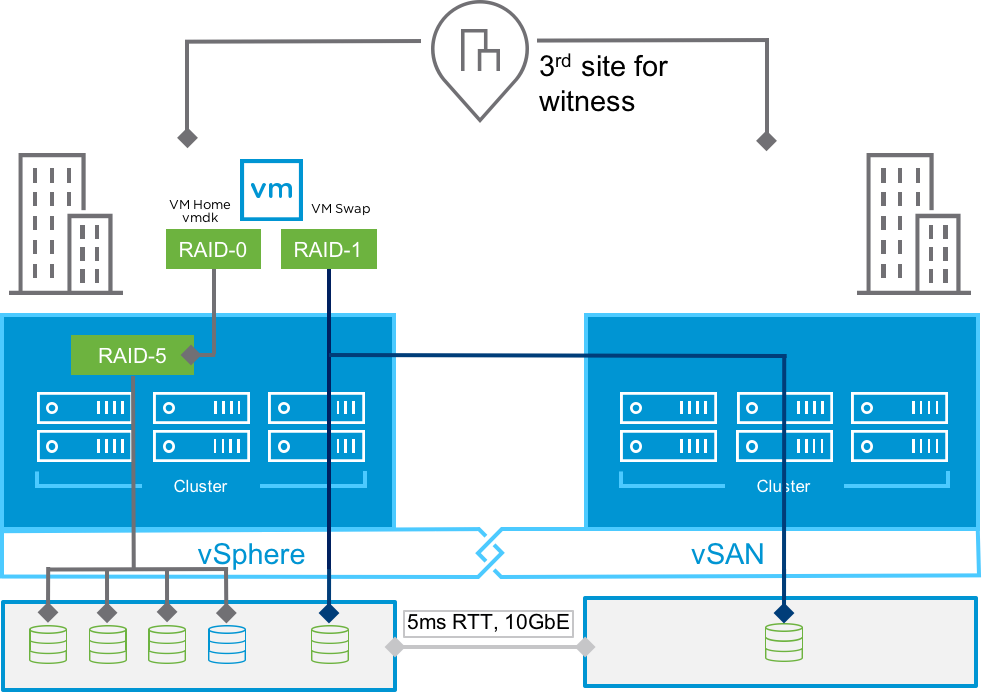VMware Hyperconverged Infrastructure (HCI) is a great fit for tactical use cases, just ask our friends over at Cubic Solutions.
To meet the needs of today’s warfighters, Cubic looked at VMware HCI, comprised of VMware vSphere and VMware vSAN. Tactical solutions typically have maximum allowable design parameters that revolve around Size, Weight, and Power or SWaP. SWaP characteristics often dictate the configuration, type of hardware used, as well as the resulting capability of the solution. Performance, capacity, and density are just a few of the raw metrics that make up a solution’s capabilities.
Overcoming SWaP challenges
Legacy tactical solutions often came with some SWaP challenges.
Selecting VMware HCI for tactical deployments, Cubic reduced weight requirements from hundreds of pounds to under 4 pounds.
This is possible because VMware HCI runs on x86 servers with local storage devices and no need for external shared storage.
Magnetic spinning hard drives have been replaced by solid-state storage devices. Smaller devices with as much capacity as magnetic hard drives allow VMware HCI the ability to meet storage requirements in a much smaller footprint.
These smaller devices also require less power than mechanical hard drives.
Meeting SWaP requirements is significantly easier with VMware HCI when compared to traditional solutions.
Overcoming traditional storage challenges
Sizing traditional storage solutions required a lot of planning pre-deployment. How much capacity is required? What performance characteristics are needed? Traditional storage solutions could easily add capacity by attaching additional drives and enclosures, but this often came at the expense of controllers providing little to no increased performance.
Sizing solutions with bigger controllers often came at a cost, which could be potentially underutilized in the event the solution is not expanded over time.
Cubic took advantage of vSAN’s flexibility, to provide multiple profile based configurations to better meet the needs of today’s warfighter.
The ability to add more drives to existing server configurations or add additional nodes gave them the ability to dynamically meet customer requirements as those needs change over time.
Overcoming skillset challenges
Different storage vendors have different storage management tools for their platforms. Individual storage vendors often have different element management tools across different versions of their own platform.
Infrastructure changes over the lifecycle of solutions can make it very difficult for administrators, or even deployed operators, to easily manage critical equipment.
These changes often result in prolonged deployment times, changes in documentation or procedures, and the effectiveness of personnel using the equipment.
VMware HCI combines the management of vSphere with the management of storage in a single familiar interface. The common interface of the most widely deployed hypervisor is fast, friendly and easy to use by skilled and novice users alike.
This common management interface ensures consistency, repeatability, and just as important, familiarity.
Overcoming deployment challenges
Traditional 2 tier architectures require independent configuration of the compute and storage components. The configuration process can change over time with the lifecycle and choice of storage systems. Storage configuration can be highly dependent on the type of media used, capabilities of the platform, number of interfaces and more. Each deviation from a standard deployment configuration could result in a less than optimal, inconsistent, and potentially vulnerable configuration.
VMware HCI can be deployed easily, repeatably, and consistently using the benefit of API integration. VMware HCI offers the ability for customers to use programming technologies such as python, ruby, java, .Net and more.
Cubic leveraged the capabilities of PowerShell and PowerCLI to standardize the deployment of VMware HCI. In fact, Cubic went even further by developing robust PowerCLI based interfaces to streamline the deployment of vSphere and vSAN. This streamlined deployment process ensures their customers can consistently deploy and configure their HCI infrastructure effortlessly.
VMware HCI is an easy decision
VMware HCI meets many of the challenges that are typically associated with tactical or edge use cases. In this post, we’ve covered a few of those, including SWaP, traditional storage paradigms, skillset and deployment. These are only a few of the challenges that vSphere and vSAN overcome. For more information about VMware HCI, and specifically, vSAN, check out storagehub.vmware.com.
p>Click the video below to hear Cubic’s experience with VMware HCI:
Check out the Cubic Mission Case Study PDF, to learn more.
This was originally posted on the VMware Virtual Blocks site: https://blogs.vmware.com/virtualblocks/2019/04/24/tactical-use-cases-why-choose-vmware-hci/


